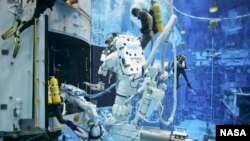For many aspiring space explorers around the world, becoming an astronaut is a childhood dream.
But have you ever wondered how one becomes a NASA astronaut? As with most things, it begins with filling out an application.
The National Aeronautics and Space Administration (NASA) received a record-breaking 18,300 applications when it announced it was looking to fill its 2017 Astronaut Candidate program.
The U.S. space agency said it will take 18 months to select eight to 14 applicants to join a new class of astronauts. The odds of getting selected are less than 0.08 percent, which makes getting into this program 65 times harder than getting into Harvard University, which has an acceptance rate of 5.2 percent.
No easy task
Selection Manager Anne Roemer said the process is no easy task.
“It’s very hard; we will do it very carefully. It starts by us reviewing all the files to make sure they meet the basic qualifications, and we actually utilize our current team of astronauts to come in and review the files as well," Roemer said.
Applicants must be a U.S. citizen and have a bachelor’s degree in engineering, biological science, physical science, computer science or mathematics. They also need at least three years of related experience or at least 1,000 hours as a jet airplane pilot.
Along with being able to pass a physical, NASA likes applicants to have certain personality traits.
“I think leadership, teamwork, the ability to both work on a team, lead a team, but also be a follower on a team," Roemer said. "Communication certainly plays a role, so it’s some pretty common skills that I think translate into even other professions.”
About 120 applicants will be invited to the Johnson Space Center in Houston for a first round of interviews. About half of them will be invited back for a second round.
Two-year training period
Once astronaut candidates are selected, they must successfully complete a two-year training period.
Roemer said they will learn a "little bit of everything about spaceflight, whether that’s systems training, they also do Russian language training, they will do EVA, Extravehicular Activities (spacewalks) training. They do a little bit of everything in that two-year window before moving into mission specific training.”
This group of astronauts may fly on three new spacecraft that are currently being developed, including NASA’s Orion, which is aimed at deep space exploration. If all goes well, NASA plans to send humans to Mars in the 2030s.
For people who are interested in pursuing a career in space, Roemer offers some advice.
“The piece of advice we always like to tell young folks that are interested is to pick a career that you are passionate and enthusiastic about, because you tend to do well with things you like, and being an astronaut would be the icing on the cake to hopefully otherwise a very fulfilling career," she said.
Since 1959, when the first group of seven astronauts were selected from the military, only 338 others have been chosen as NASA astronauts.
Shan Xu contributed to this report.











